Canon ELPH 340 / IXUS 265 review
-
-
Written by Ken McMahon
Intro
The Canon IXUS 265 HS is a 16 Megapixel compact with a 12x optical zoom. In North America it’s called the ELPH 340 HS, so from now on I’ll refer to it as the IXUS 265 HS / ELPH 340 HS. Strictly terms of naming, the IXUS 265 HS / ELPH 340HS is an update to the 2013 IXUS 255 HS / ELPH 330 HS. But with the rise of the smartphone camera, the point-and-shoot market is a smaller, tougher place and both the IXUS and PowerShot ranges have been rationalised. The IXUS 265 HS / ELPH 340 HS is now the flagship model
Broadly speaking, last year’s IXUS / ELPH range was split into two halves, the lower end based on the 16 Megapixel CCD sensor and Digic 4 processor and the top half benefitting from the newer 12 Megapixel CMOS sensor and Digic 5 processor combination – these were the HS models denoting ‘High sensitivity’ that performed better in low light coupled with an all-round higher specification.
For the IXUS 265 HS / ELPH 340 HS the sensor resolution has been increased to 16 Megapixels; it’s still a CMOS sensor, hence the IXUS 256 HS / ELPH 340 HS is the only 2014 IXUS / ELPH to carry the HS suffix, but the processor has been downgraded to the Digic 4+.
Better news is that the new model gets a longer zoom lens now offering a 12x ratio with a range of 25-300mm. The 3 inch 461k dot LCD screen remains as does full HD video and the new model retains the Wifi but adds NFC for hassle-free connection to a suitably equipped smartphone. Here I’ve compared the IXUS 265 HS / ELPH 340 HS alongside Sony’s Cyber-shot WX350 which at 20x has a longer zoom reach, and a slightly more expensive price tag. I’ve also tested the Panasonic Lumix SZ8, a less expensive model that matches the IXUS 265 HS / ELPH 340 HS’s 12x range. Read on to find out which of these mid-range point-and shoot models offers the best step up from a smartphone for your money.
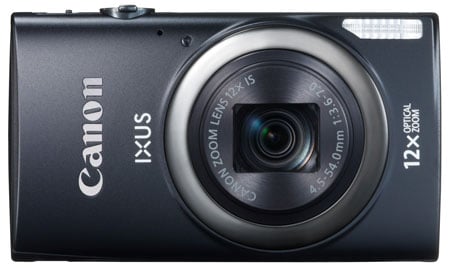
Canon IXUS 265 HS / ELPH 340 HS design and controls
The IXUS 265 HS / ELPH 340 HS looks remarkably similar to its predecessor the IXUS 255 HS / ELPH 330 HS. A cynic might conclude that Canon’s keeping its design and development costs down, but why change something that works? The design still looks bang up to date, the IXUS 265 HS / ELPH 340 HS is a comfortable fit in the hand and it slides easily in and out of pockets.
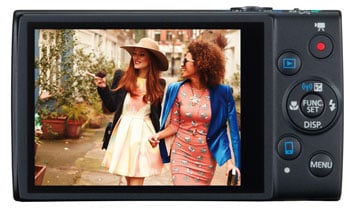
In one major change from the previous model, the mode switch has been relocated from the rear of the camera to the top panel. In addition to the shooting mode and Hybrid Auto positions there’s also now a new middle position for the Creative Shot mode. The small, recessed on/off button sits on the other side of the large shutter release button with its zoom collar surround.
On the back, the controls are all arranged to the right of the screen. There’s the familiar Canon four-way controller with central Func. Set button used to navigate menus and for one touch setting of exposure compensation, flash, display modes and macro focus. Movie record, playback and menu buttons are joined by newcomer labelled with a blue smartphone icon, no prizes for guessing this is for making a quick Wifi connection to your phone, something I’ll talk about more in the Wifi section of my review.
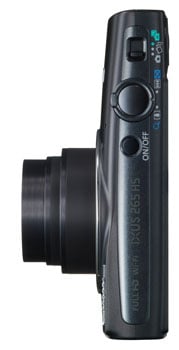 |
The screen is a 3 inch 461k dot LCD that’s one step up from the 230k dot panel you’ll find on point and shoot models costing less. It’s well detailed and, typically for a Canon compact, provides a bright punchy image with fairly accurate colour rendition, though actual picture quality is of course unaffected by this. I used the IXUS 265 HS / ELPH 340 HS quite a lot outdoors in bright sunlight and, though no screen does well when the sun is shining directly on it, the IXUS 265 HS / ELPH 340 HS was far better than either the Sony WX350 or the Lumix SZ8.
It doesn’t have a particularly wide angle of view though in either the horizontal or vertical directions, though the WX530 and Lumix SZ8 didn’t fare any better. And another criticism that could be made of it is that it’s not a touch screen. Touch screen technology it seems is something Canon no longer sees a place for in this series, the PowerShot N and N100 are the only two models in the budget compact range to offer touch screens.
The built-in flash is located on the front panel in the extreme top left (as you hold the camera) corner, so you need to be careful to keep your fingers out of the way, If you hold the camera two-handed it’s all too easy for the middle finger of your right hand to overhang. The flash has a maximum range of 4 metres at the wide angle lens setting, much the same as the Sony WX350 but a little less than the 5.2 metres quoted for the Lumix SZ8. But if you want more power you can fit Canon’s HF-DC2 external flash to the IXUS 265 HS / ELPH 340 HS, neither the WX350 nor the Lumix SZ8 offers an external flash accessory.
The combined battery and card compartment is accessed by a hinged door in the base. The IXUS 265 HS / ELPH 340 HS takes SD cards. The 800mAh NB11LH batter provides enough power on a full charge for a fairly meagre 190 shots. But but switch to Eco mode and you can increase that to 290 shots. Eco mode dims the screen after a couple of seconds inaction, then turns it off ten seconds later, and after a further three minutes turns the camera off altogether. Even in ECO mode though, the IXUS 265 HS / ELPH 340 HS’s battery life falls well short of the 470 shots the WX350’s battery provides, though it will outlast the 200 shot Lumix SZ8.
Canon IXUS 265 HS / ELPH 340 HS lens and stabilisation
The IXUS 265 HS / ELPH 340 HS has a 12x optical zoom with a range of 25-300mm and a maximum aperture of f3-6.7. This a great range to have at your disposal in a pocketable compact and with a 25mm wide angle is a far more useful range than in the earlier 12x IXUS / ELPH model, the The ELPH 520 HS / IXUS 500 which started at 28mm (the ELPH 520 HS / IXUS 500 also had a 16 Megapixel CMOS sensor, but only used the central portion of it for imaging, hence the larger crop factor and longer equivalent focal length).
The Lumix SZ8 has a similar range of 24-288mm. It’s a small difference though and not really worth worrying about if you’re deciding between the two. The Sony WX350 is a different story. It starts at the same 25mm wide angle, but extends to 500mm compared with 300mm on the IXUS 265 HS / ELPH 340 HS. To see how much of a difference that makes, as well as the usual wide angle and telephoto angle of view comparison, in the table below I’ve compared the 300m maximum telephoto of the IXUS 265 HS / ELPH 340 HS with the 500mm on the Sony WX350.
IXUS 265 HS / ELPH 340 HS wide | IXUS 265 HS / ELPH 340 HS tele |
 |  |
| 4.5-54mm at 4.5mm (25mm equiv) | 4.5-54mm at 54mm (300mm equiv) |
IXUS 265 HS / ELPH 340 HS tele | Sony WX350 coverage tele |
 |  |
| 4.5-54mm at 54mm (300mm equiv) | 4.3-86mm at 86mm (500mm equiv) |
The IXUS 265 HS / ELPH 340 HS is equipped with Intelligent IS optical image stabilisation which uses scene detection to decide how best to apply stabilisation. There are three modes, Off, Shoot only and Continuous. Image stabilisation needs power, something you have to keep an eye on with the IXUS 265 HS / ELPH 340 HS, with it enabled you’ll get fewer shots from a full charge. Shoot only cleverly applies stabilisation just before you shoot, saving on battery power but, unlike earlier models, it isn’t activated when you half-press the shutter, only at the instant of exposure. So if you want to see a steady image on the screen you need to set Continuous mode.
To test Intelligent IS on the IXUS 265 HS / ELPH 340 HS I took a series of shots in fading light at progressively slower shutter speeds first with IS turned off and then with it on in continuous mode. As you can see from the 100 percent crops below, the IXUS 265 HS / ELPH 340 HS is capable of producing sharp shots hand-held at shutter speeds down to 1/15. I was able to get the occasional sharp shot at 1/8, but not consistently. Even so, this represents a very respectable four stops slower than the photographer’s ‘one over the focal length’ rule of thumb.

100% crop. 4.5-54mm at 54mm, 100 ISO, 1/15th, IS off.
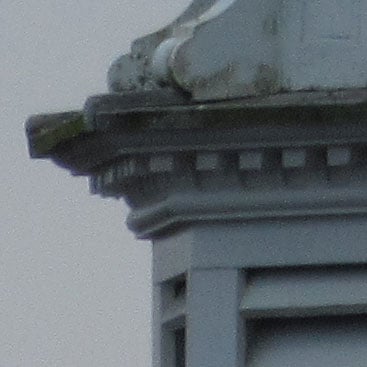
Canon IXUS 265 HS / ELPH 340 HS shooting modes
The shooting mode switch on the top panel of the IXUS 265 HS / ELPH 340 HS has thee positions; in the first position you can select the shooting mode by pressing the centre button on the four-way controller to access the Func. Set quick menu. The second position selects Creative Shot mode and the last is for the Hybrid Auto movie mode.
Let’s start with the shooting modes. The Auto mode on the IXUS 265 HS / ELPH 340 HS is called ‘Smart’ Auto for good reason. It uses scene detection to help produce the best possible exposure. The Digic 4+ processor is able to determine 32 different scene types broadly divided according to whether people are present in the frame and the lighting conditions. The IXUS 265 HS / ELPH 340 HS can tell the difference between day and night, whether the sky is blue, and if the subject is backlit or moving and how close it is.
It can’t tell if you’re taking photos of your baby, or sunsets or if the camera is on a tripod. That kind of thing is the realm of the Digic 5 which can recognise 58 scene types. So the IXUS 265 HS / ELPH 340 HS isn’t quite as smart as the earlier, Digic 5-based IXUS 255 HS / ELPH 330 HS. All the same, it has to be said, the new model does an excellent, though not flawless job of recognising what’s in front of it and setting the exposure and focus accordingly.
Switch to Program Auto and you lose the scene detection but gain the ability to change other settings like Exposure compensation, ISO sensitivity, white balance and AF mode. Scroll down the mode menu and you’ll find a variety of scene modes including the Handheld NightScene low-light stacking mode, Smart Shutter, High-speed burst and creative effects filters. Shown below you can see from left to right on the top row Fish-Eye Effect, Miniature and, Toy Camera Effect, and on the the bottom row Monochrome, Super Vivid, and Poster Effect.
 |  |  |
 |  |  |
Push the mode switch one click to the right and you enter Creative Shot mode. Introduced on recent Canon compacts and entry level DSLRs, Creative Shot mode is an extension of the filter effects which automatically applies a selection of them to a shot to produce six variations. The IXUS 265 HS / ELPH 340 HS uses scene detection to determine which effects to apply and it also crops some images to produce new compositions. All six versions are then displayed for a couple of seconds and if you press the Func Set button you can review them individually though, of course, you can play them back at any time just like other shots. The IXUS 265 HS / ELPH 340 HS also includes the Smart shutter modes which automatically fire the shutter when a smile is detected or start the self time when you wink or when a new face enters the frame.
Canon IXUS 265 HS / ELPH 340 HS movie modes
The IXUS 265 HS / ELPH 340 HS can shoot full HD video at 1080p30 and also has a 720p30 and VGA mode. You can start recording at any time by pressing the red button conveniently situated for your thumb on the rear panel. The exposure and sensitivity are set automatically and the screen display alters to 16:9 proportions for HD recording with black bars top and bottom. Audio is recorded via a mono microphone, you can just see the tiny hole for it below the shutter button on the front panel.
In the 1080p30 HD mode movies are encoded at an average bit rate of 30Mbits/s using the H.264 codec and saved as QuickTime files with an .mp4 extension in the same folder as images. You’ll get around 32 minutes of footage on an 8GB card, but the longest continuous recording time is a minute shy of half an hour or when the file size reaches 4GB – so more likely around 16 minutes or so. Canon recommends and SD card of Speed Class 4 or higher for movies.
| |
|---|---|
| |
| |
| |
|---|---|
| |
| |
| |
|---|---|
| |
| |
| |
|---|---|
| |
| |
Canon IXUS 265 HS / ELPH 340 HS Wifi
Like its predecessor, the IXUS 265 HS / ELPH 340 HS is equipped with Wifi but the new model adds NFC connectivity which means that if you have a suitably equipped smartphone you can connect the two devices simply by tapping them together. You don’t have to have an NFC equipped phone though, by pressing the mobile device connection button on the rear of the camera you can setup a wifi connection between the camera and your phone in less time than it takes to say ‘mobile device connection button’.
 |  |  |
I tested the wifi features of the IXUS 265 HS / ELPH 340 HS using my iPhone 4S. Canon’s CameraWindow app allows you to transfer images and remotely control the camera. The CameraWindow iOS app offers fairly basic remote shooting features. You can zoom in and out remotely – a slider and nudge buttons on the app provide the same level of control as on the camera – but other than the option to set either a 2 or 10-second self timer that’s about it. You can set the flash mode and you can take a shot by pressing the big shutter release button at the bottom of the screen, but you can’t change the exposure or tap the screen to set the focus point like you can on the Lumix SZ8
The CameraWindow app also allows you to view all of the images on the camera and transfer them to your phone. you can transfer the original JPEGs or there are two resizing options, medium and small. Canon’s CameraWindow app is faster at displaying image thumbnails and I could view individual images at screen size on my iPhone, but unlike the Panasonic app, you can’t pinch to zoom.
Though the IXUS 265 HS / ELPH 340 HS lacks a built-in GPS receiver, as on the Lumix SZ8, you can use your phone’s GPS to record a track log then append the GPS data to images in the camera. It’s a little more involved than using a built-in GPS which you just turn on and forget about, but a feature worth having nonetheless.
Using your smartphone is almost certainly the best way to share photos having copied them from the camera, but there’s also the option to wirelesly transfer photos to a computer, the Web, a suitably equipped printer or another camera by pressing the up button on the four-way controller during playback. One of the drawbacks of this for sharing to social media and photo sharing sites is that you need to register an account on Canon’s Image Gateway platform which is then used as an intermediary.
Canon IXUS 265 HS / ELPH 340 HS handling
The IXUS 265 HS / ELPH 340 HS starts up reasonably swiftly and is ready to take a picture in just under two seconds. The single speed zoom covers the 25 to 300mm at a fair lick, completing the distance in around two seconds. The zoom collar is quite sensitive though, and can be nudged in small steps for fine control.
I wonder whether Canon has changed the shooting mode switch in response to user feedback or simply to give more prominence to the Creative Shot and Hybrid Auto features. Whatever the reason, I’m glad they did as they’re both excellent features that are more likely to get used if you don’t have to go hunting through a menu for them.
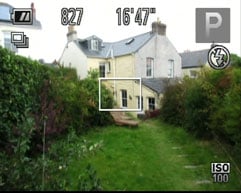 | 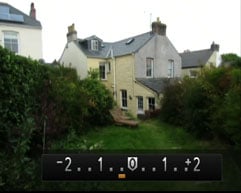 | 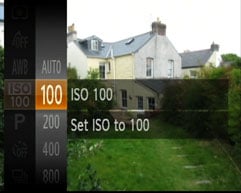 |
 | 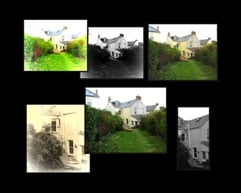 |  |
Not that the IXUS 265 HS / ELPH 340 HS requires much delving. Between them, the two-tab menu and the Func. Set quick menu provide ready access to the most frequently used settings. If there’s anything to complain about here it’s that the mode menu is a bit of a hotchpotch, with everything, Smart Auto, Program Auto, Portrait scene mode, Smart Shutter. High-Speed burst, Handheld NightScene, then more scene modes all in one long list, but at least it scrolls quickly.
The Focusing is quick and reliable, Face AiAF with it’s 9-area default has been around for long enough for Canon to hone it. Like the Scene detect modes though, it is one of those things that’s quicker, better, more reliable on models with a Digic 5 processor, so in that sense it’s a backward step for the IXUS 265 HS / ELPH 340 HS.
One thing that hasn’t suffered is continuous shooting. Far from it the IXUS 265 HS / ELPH 340 HS improves on its predecessor’s 2.4fps with a 3.9fps full resolution continuous shooting mode. I tested it by fitting the IXUS 265 HS / ELPH 340 HS with a Sandisk Extreme pro 8GB UHS-1 card and fired a burst of 10 frames at Large SuperFine quality. Disappointingly the actual speed fell below the quoted 3.9fps and the best I could mange was 2.6fps. I tried reducing the quality to Fine and turning off the stabilisation, and even experimented with different cards, but none of it made a difference. In High-Speed Burst mode the IXUS 265 HS / ELPH 340 HS managed just under 5fps – again, well under the quoted 10.5fps rate. That performance is all the more disappointing when compared with the Sony WX530’s 10fps, though it’s still better than the 1.2fps Lumix SZ8.
Canon IXUS 265 HS / ELPH 340 HS Sensor
The IXUS 265 HS / ELPH 340 HS has a 16 Megapixel CMOS sensor and Digic 4+ processor producing images with a maximum size of 4608×3456. Images are saved as JPEG files at one of two quality/compression settings. Large SuperFine JPEGs are, on average around 6 to 10MB in size. The sensitivity range is 100-3200 ISO and the shutter speed range is 15 – 1/2000 (1 – 1/2000 in Auto modes)
 Canon's PowerShot IXUS 265, or ELPH 340 as it's known in North America, is a 16 Megapixel point-and-shoot compact with a 12x optical zoom, 1080p video and Wifi with NFC. The 25-300mm zoom range is what sets it apart from camera phones or more basic compacts, and the built-in Wifi makes it easy to transfer and share images. All this in a stylish and affordable body make the latest IXUS / ELPH a desirable buy, but to make sure we've compared it against Sony's WX350 and the Lumix SZ8.
Canon's PowerShot IXUS 265, or ELPH 340 as it's known in North America, is a 16 Megapixel point-and-shoot compact with a 12x optical zoom, 1080p video and Wifi with NFC. The 25-300mm zoom range is what sets it apart from camera phones or more basic compacts, and the built-in Wifi makes it easy to transfer and share images. All this in a stylish and affordable body make the latest IXUS / ELPH a desirable buy, but to make sure we've compared it against Sony's WX350 and the Lumix SZ8.



